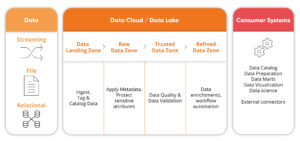
Navigating the Pros and Cons of Setting Up a Data Cloud Environment
In today’s data-driven world, organizations are increasingly turning to data cloud environments to streamline their data management processes. These environments offer a range of benefits, from efficient data integration and processing to enhanced data security and accessibility. However, like any technology, data cloud environments also come with their own set of challenges. In this article, we will explore the pros and cons of setting up a data cloud environment with various components – data, different data cloud zones, and consumer systems.
Pros of Setting Up a Data Cloud Environment:
- Efficient Data Management:
By centralizing data from various sources (streaming, relational, archived data, etc.), a data cloud environment enables efficient data management. This facilitates easier data ingestion, tagging, cataloging, and subsequent retrieval and analysis.
- Data Governance and Security:
Data cloud environments provide dedicated data zones, like the Data Landing Zone (DLZ), Raw Data Zone (RDZ), Trusted Zone (TZ), and Refined Data Zone (RDZ). These zones ensure better data governance, metadata management, and allow for the protection of sensitive data. Data quality and validation in the Trusted Zone enable organizations to maintain data accuracy and integrity.
- Enhanced Data Analytics:
By leveraging advanced analytics tools, data cloud environments allow organizations to gain deeper insights and make data-driven decisions. These environments offer integrated data catalogs, data preparation tools, and data visualization capabilities, enhancing the overall analytics process.
- Streamlined Workflows:
The Refined Data Zone in a data cloud environment facilitates data enrichment and automated workflows. This allows organizations to streamline processes, reduce manual intervention, and achieve greater operational efficiency.
- Collaborative Approach:
Data cloud environments enable collaboration between various departments and stakeholders. The availability of departmental data marts and external connectors fosters information sharing and cross-functional analysis, leading to improved decision-making.
Cons of Setting Up a Data Cloud Environment:
- Initial Setup Complexity:
Implementing a data cloud environment involves careful planning, infrastructure requirements, and integration of various components. This can be time-consuming and may require expertise and resources, leading to potential complexities during the setup phase.
- Cost Considerations:
While data cloud environments offer significant benefits, they also come with costs. There may be expenses associated with infrastructure, software licenses, data storage, and ongoing maintenance. Organizations need to carefully evaluate these costs and consider long-term ROI.
- Data Integration Challenges:
Integrating diverse data sources and ensuring compatibility across systems can pose challenges. Data from streaming, relational, and archived sources may require different ingestion techniques and processing methods. Organizations need to address these integration challenges to optimize data usage.
- Data Security Risks:
Although data cloud environments provide enhanced security features, they also introduce potential vulnerabilities. Organizations must have robust data governance and security measures in place to protect against data breaches, unauthorized access, and privacy concerns.
Conclusion:
A data cloud environment has the potential to revolutionize an organization’s data management practices, providing efficient data integration, security, analytics, and collaboration. However, it is essential to carefully evaluate the pros and cons before implementation. With proper planning, investment, and ongoing management, a well-designed data cloud environment can enable organizations to harness the power of their data and drive successful outcomes.
Remember, the key lies in understanding your organization’s specific needs, goals, and resources to make informed decisions and leverage the full potential of a data cloud environment.
